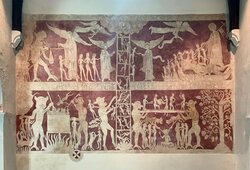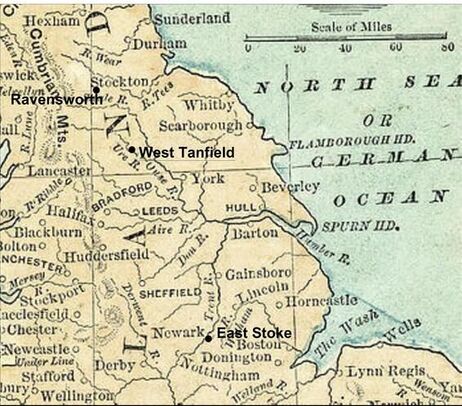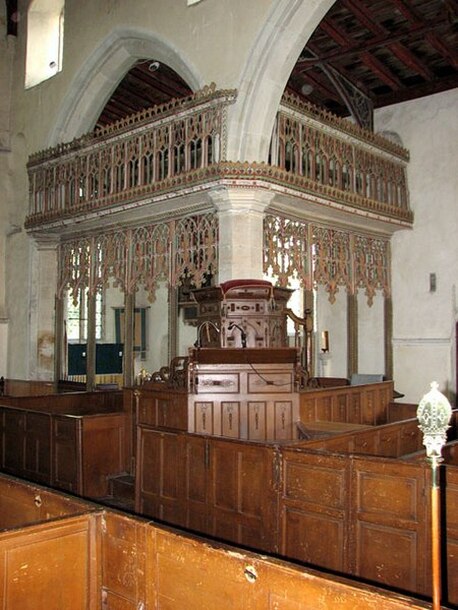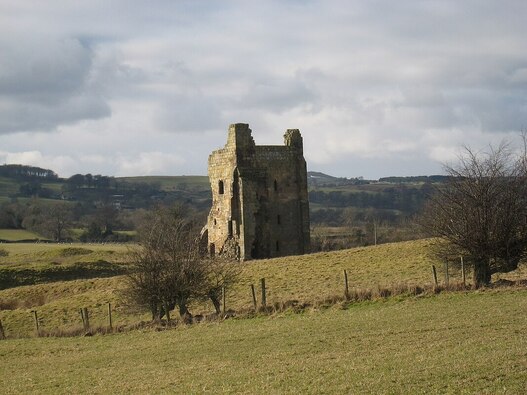
Why was Purgatory so Important?
In the middle ages, the church taught that the moment a person died, their soul entered Purgatory, a place from which it could only be released by the prayers of those still living. The time their soul spent there was governed by what sins they had committed and the effectiveness of the prayers that were said for them.
When Francis Lovel was alive, all churches had wall paintings, some of which illustrated Purgatory. The one shown in the picture still survives at Chaldon in Surrey and has a ladder with the souls of people who have died, initially moving down to Purgatory but later ascending to Heaven because of the prayers of those they had left behind.
So powerful was the belief in the pains of Purgatory that people went to great lengths to reduce the time their soul spent there. Those that could afford to do so, founded a chantry chapel, and appointed a priest to pray and conduct Masses to speed their soul through Purgatory from the moment they died. Most such foundations were made by individuals who were coming to the end of their lives and who set aside the rent from some of their lands to ensure that their priest was paid continuously and his prayers would not be interrupted.
The easiest place for a person to found a chantry was in their own parish church where they already had sufficient influence to secure agreement for its establishment, knew all the local craftsmen they needed, owned sufficient land in the parish to provide rent to pay the priest and could expect their sons and future generations of their family to ensure that the priest continued to offer his prayers which were quite independent of the activities of the parish priest who said his Masses at the High Altar.
Whilst some chantry chapels were housed in extensions to the church building many of them comprised a small enclosure within the church separate from the rest of the building, which contained an altar for the chantry priest to say daily prayers and often the founder's tomb.
Would Anne have wanted to comply with Francis’ wishes for a chantry?
It would be very surprising if Anne had made no effort to found a chantry for Francis because of the number of chantries that surrounded her as she grew up in the FitzHugh household. Her uncle Richard had helped found a chantry for victims of the Battle of St Albans, there was a chantry for her grand-parents at Middleham, her great-grandfather Ralph founded a college of priests at Staindrop near to their mother’s home at Raby, her great-great-grandfather John founded a chantry at Durham cathedral and his father Ralph founded another chantry at Staindrop. In addition one of her uncles had augmented the chantries at West Tanfield that had been founded by Maude Marmion, her great-great-grandmother.
Not only was Anne surrounded by chantries founded by her ancestors, she had the example of her father, Henry, who made a pilgrimage to the Holy Sepulchre thereby obtaining indulgences reducing his time in Purgatory and having returned, founded his own chantry with two priests to celebrate divine service daily in the chapel he built in his castle at Ravensworth, the remains of which are shown below.

Anne’s father died in 1472, and her mother enrolled the younger members of the family into the Guild of Corpus Christi in York which required them to ‘say yearly for the souls of their departed brethren the Psalter of the Virgin’ and to ‘ be present at the Mass on the Sunday within the Octave of the [Corpus Christi] festival’.
Anne received a grant of £20 from Henry VII on 10 December 1490 where she is referred to as being ‘beloved in Christ’ suggesting that she may have entered a convent by that time.
Anne's difficulties when founding Francis’ Chantry
Anne had three major difficulties in carrying out Francis wish for her to found a chantry.
a) Francis was last seen alive leaving the battlefield at East Stoke
At the time of the Battle of East Stoke, Anne probably would have lived with he brother at Ravensworth, their ancestral home, or at the family dower house at West Tanfield. The map shows that Ravensworth was well over a hundred miles from East Stoke and West Tanfield more than ninety.
Anne received a grant of £20 from Henry VII on 10 December 1490 where she is referred to as being ‘beloved in Christ’ suggesting that she may have entered a convent by that time.
Anne's difficulties when founding Francis’ Chantry
Anne had three major difficulties in carrying out Francis wish for her to found a chantry.
a) Francis was last seen alive leaving the battlefield at East Stoke
At the time of the Battle of East Stoke, Anne probably would have lived with he brother at Ravensworth, their ancestral home, or at the family dower house at West Tanfield. The map shows that Ravensworth was well over a hundred miles from East Stoke and West Tanfield more than ninety.

b) Henry VII had condemned Francis as a traitor and his wealth had been taken from him.
In 1485 when Francis gave his wife instructions to found an institution at Oxford or Cambridge he had substantial power and influence but by 1487 Anne no longer had the means of doing this because the Act of Attainder following the Battle of Bosworth had taken away all of Francis' wealth and designated him a traitor to the new regime.
Anne's resources were confined to the five manors in Northamptonshire that Francis instructed his feoffees to convey to her after his death so she was obliged to create a more modest and more discreet form of chantry chapel than the elaborate example on the right which was founded for Francis' great-grand parents at Dennington, Suffolk in 1441.
c) Francis and Anne had no sons to help Anne create the chantry
Most widows in Anne’s position would have had sons to take on the task of founding a chantry chapel; all the more necessary when it had to be undertaken far from the family’s home parish, but Anne and Francis did not have a son. She therefore needed the services of a reliable and trustworthy person to do it for her and take on the role of the son she and Francis never had.
That person had to be someone she could trust to make decisions on her behalf, engage competent craftsmen, negotiating with church authorities. When the chantry chapel had been built he had to engage a priest and secure sufficient rent to pay him indefinitely. Anne looked for a person with such capabilities within her own family but there was only one available.
Click HERE to find out which member of the family became Anne's helper.
In 1485 when Francis gave his wife instructions to found an institution at Oxford or Cambridge he had substantial power and influence but by 1487 Anne no longer had the means of doing this because the Act of Attainder following the Battle of Bosworth had taken away all of Francis' wealth and designated him a traitor to the new regime.
Anne's resources were confined to the five manors in Northamptonshire that Francis instructed his feoffees to convey to her after his death so she was obliged to create a more modest and more discreet form of chantry chapel than the elaborate example on the right which was founded for Francis' great-grand parents at Dennington, Suffolk in 1441.
c) Francis and Anne had no sons to help Anne create the chantry
Most widows in Anne’s position would have had sons to take on the task of founding a chantry chapel; all the more necessary when it had to be undertaken far from the family’s home parish, but Anne and Francis did not have a son. She therefore needed the services of a reliable and trustworthy person to do it for her and take on the role of the son she and Francis never had.
That person had to be someone she could trust to make decisions on her behalf, engage competent craftsmen, negotiating with church authorities. When the chantry chapel had been built he had to engage a priest and secure sufficient rent to pay him indefinitely. Anne looked for a person with such capabilities within her own family but there was only one available.
Click HERE to find out which member of the family became Anne's helper.

